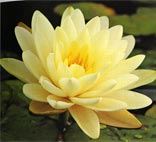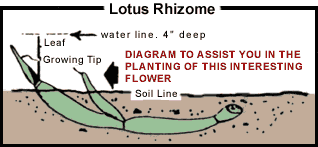SOIL: All aquatic plants should be planted in a rich clay based topsoil. Try to avoid soil with a lot of compost or peat, as the lighter materials tend to float. Most commercially bagged and sterilized soil is not suitable for aquatic plants, because they contain these materials. The commercially bagged soil that we recommend is our Moore Water Garden Soil (see Soil). It has been tested at our nursery and has proved to allow for good development of water lilies and aquatic plants.
CONTAINERS: Plastic containers are recommended because they are sturdy yet light in weight. Marginal or bog plants can be planted in any suitable container, usually 8″-10″ across, but the bigger the better. Keep in mind that aquatic plants will grow proportionately to the size container in which they are planted. Too small containers will slow their growth by allowing them to become overcrowded quickly. For more stability, use wide base pots for tall, emergent plants. Most water lilies require large containers from 15″ to 24″ across, with a capacity of 27 litre (3/4 bu.) of soil per lily or larger. Dwarf lily varieties can be planted in 10″ to 12″ pots, but at least an 18 litre (1/2 bu.) container is recommended. Lotus require at least a 27 litre container, but prefer larger containers with rounded corners. Even Dwarf Lotus need at least a 27 litre container. Use 8″ pots or shallow trays to plant oxygenating plants. (See Planting Supplies).
Planting Bareroot Hardy Water Lilies
Bare-root hardy lilies may be planted from late April until June. May and June are the best months. If using organic fertilizer, add moistened soil/fertilizer mixture into the bottom half of an 18 to 27 litre (1/2 to 3/4 bu.) container (see fertilizing directions for mixing instructions). If using fertilizer tablets, just half fill with moistened soil. Be sure soil is tamped to firm. Some hardy lilies (such as Chromatella) should be planted almost vertically. Other lily roots grow at a 45° angle while odorata rhizomes grow almost horizontally. Check the angle at which the leaves and rhizome meet. This is the correct planting angle. Place the lily in the tub so that the cut end is close to the edge of the container, with the crown (from which the leaves grow) toward the middle of the tub. This allows the most room for growth.

Add more moistened soil (without organic fertilizer) to fill the tub to within a couple of inches from the top. Water lilies must be planted so that the crown is even with or slightly above the surface of the soil. If using fertilizer tablets, push 5-6 tablets into the soil around the crown of the lily. Tamp soil down gently, being sure to fill the holes made by the fertilizer tablets. Cover soil with a layer of gravel, making sure there is NO SOIL OR GRAVEL ON THE CROWN. The gravel will keep the soil from being stirred up and discolouring the water and also prevents the fish from uprooting the plants. It is a good idea to soak the soil with some warm pond water before placing the containers in the pond. This allows air bubbles to escape and avoids muddying the pond water. Water lilies are heavy feeders and should be fertilized with 4 fertilizer tablets once a month from April to August for maximum bloom and growth.
Transplanting Potted Hardy and Tropical Lilies
Potted hardy lilies can be transplanted into larger containers until September. Transplant tropical lilies in June when the water temperature has warmed to above 70°F (20°C). Cold water will cause the young plants to become dormant. Tropical lilies and hardy lilies must be transplanted from their original pots to an 18-27 litre container or larger. If left in the original containers, the lilies will become pot bound, which will stunt their growth. Therefore, a large container allows room to grow, so that your lily will grow to its full potential and bloom frequently. Fill the large container half full of moistened, tamped down soil. If using organic fertilizer, add a mixture of fertilizer and soil. Carefully remove the original pot from the lily and place the lily (soil and all) into the centre of the large container. Fill the remaining space with moist soil leaving about 1 inch from the top of the pot. Tamp soil down gently. If using fertilizer tablets, put 5-6 tablets around the pot and cover with soil. Cover soil with a layer of gravel, making sure there is NO SOIL OR GRAVEL ON THE CROWN. The gravel will keep the soil from being stirred up and discoloring the water and also prevents the fish from uprooting the plants. It is a good idea to soak the soil with some warm pond water before placing the containers in the pond to avoid muddying the water. Water lilies are heavy feeders and should be fertilized with 4 fertilizer tablets once a month from April to August for maximum bloom and growth.
Positioning Your Lilies
Position your lilies in the middle of the pond about 5-6 feet apart. Initially, it is best to have the lilies at the shallower depth (6″ of water) and then gradually move them deeper as the lily grows. You may need to use blocks to raise the lilies to the proper depth. Water lilies will grow in 6″ up to 3′ of water, depending on the variety. Do not place water lilies close to waterfalls or fountains where they will be splashed.
Bare-root lotus may be planted from late April to early June. Lotus should be planted into a 27 litre (3/4 bushel) container or larger. The container must be solid with rounded corners, i.e. no holes, or the lotus will escape from the tub. Fill the container 3/4 full of moistened, firmed soil. Set the lotus rhizome on top of the soil. Dig a trench in the soil beneath the rhizome 2″ deep. Set the rhizome into the trench. Cover the rhizome with soil, just enough to fill the trench, being careful not to damage or cover the growing tips which are very fragile.

Push 6 to 8 fertilizer tablets per 27 litre tub into the soil around the rhizome and cover any holes with soil. Gently tamp down soil. Add thin layer of pea gravel, making sure there is no gravel on the growing tips, as they will have a hard time growing up through the gravel. The gravel will keep the soil from being stirred up and discolouring the water. Soak the soil with pond water before placing the containers in the pond to prevent muddying the pond water. In the spring, lotus tubs should be placed so 1″ to 2″ of water is above the top of the tub. Blocks may be needed to raise the tubs up in deeper areas. This allows for more sunlight and heat to stimulate growth. As growth becomes established with aerial leaves, water depth may be increased to 6″ or 8″ of water above the top of the tub. Similar to lilies, lotus should not be placed close to waterfalls or fountains where they will be splashed. Lotus are heavy feeders and should be fertilized once a month with 4 to 6 fertilizer tablets from April to August, for maximum growth and bloom.
Oxygenating plants should be planted in moist soil in their own pots. An 8″ pot is large enough to accommodate 1 bag of oxygenating plants. Remove oxygenating cuttings from the mesh bag and tuck half the plant stem into the moistened soil. Bury the root system of the individual plants in the soil. Leave the soil level about 1″ below the top of the pot and fill the remaining space with gravel. Soak the soil with pond water to prevent muddying up the water when the plants are placed in the pond. Place pots directly on the bottom of the pond between the lily tubs.
NOTE: Hornwort does NOT need to be planted, it floats in the pond.
Planting Bareroot Hardy and Tropical Shallow Water Plants
Bare-root hardy plants can be planted from late April to late June. Tropical plants can be planted from late May (when there is no risk of frost) to August. Marginal plants should be potted into an 8″ pot or larger. Keep in mind that wide based pots are more stable for tall plants. Fill the 8″ pot half full of moistened, tamped soil. Don’t cover the holes at the bottom, as they allow for the roots to grow out into the water. Place the plant into the centre of the pot. Then add more soil so that the roots are well covered. Leave the crown of the plant, from which the leaves grow, protruding from the soil. Push 2-3 fertilizer tablets into the soil around the crown. Tamp soil down gently. Cover the soil with a layer of gravel and soak with pond water before placing the pot into the pond to prevent muddying up your pond water. Fertilize monthly to encourage growth and bloom.

Transplanting Potted Shallow Water Plants
Potted plants may be transplanted at any time. Half fill an 8″ pot (or larger) with moistened tamped soil. Carefully remove the original pot from the plant and place the plant (soil and all) into the centre of the pot. Fill the remaining space with moist soil leaving about 1 inch from the top of the pot. Tamp soil down gently. Cover soil with a layer of gravel, leaving the crown of the plant protruding. The gravel will keep the soil from being stirred up and discoloring the water and also prevents the fish from uprooting the plants. Soak the soil with some warm pond water before placing the containers in the pond to avoid muddying up your pond water. Fertilize monthly to encourage growth and bloom.
Positioning Shallow Water Plants
Marginal plants are often situated on the pond shelves; adjustments may be required for proper depth. See Hardy and Tropical Marginal pages for proper planting depth. If shelves are full, try using blocks or inverted pots to position plants at proper depth anywhere in the pond.
Directions for Fertilizer Tablets:
Use 6 tablets per 18-27 litre lily or lotus container in the spring or when first planting. Use 2-3 tablets per 8″ pot for shallow water plants. Your lilies should be fertilized monthly with 4 tablets per lily container and 1-2 tablets per 8″ pot for shallow water plants. Be sure to keep the tablets a few inches away from the crown to prevent burning. Push the fertilizer tablet as far down as you can with your finger. Then fill in the holes with soil to prevent the fertilizer from leaching into the water. Do not fertilize hardy plants after mid August.





